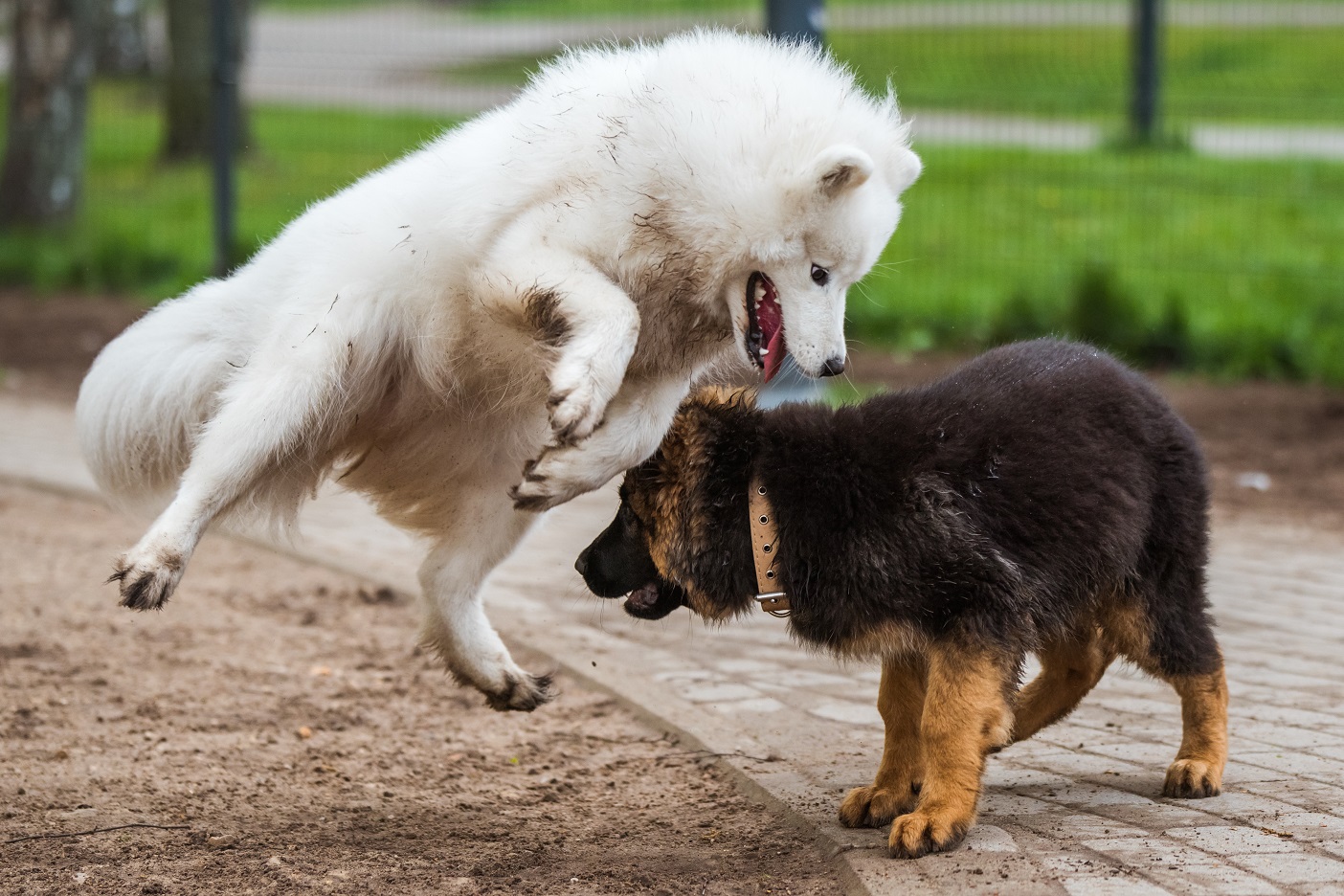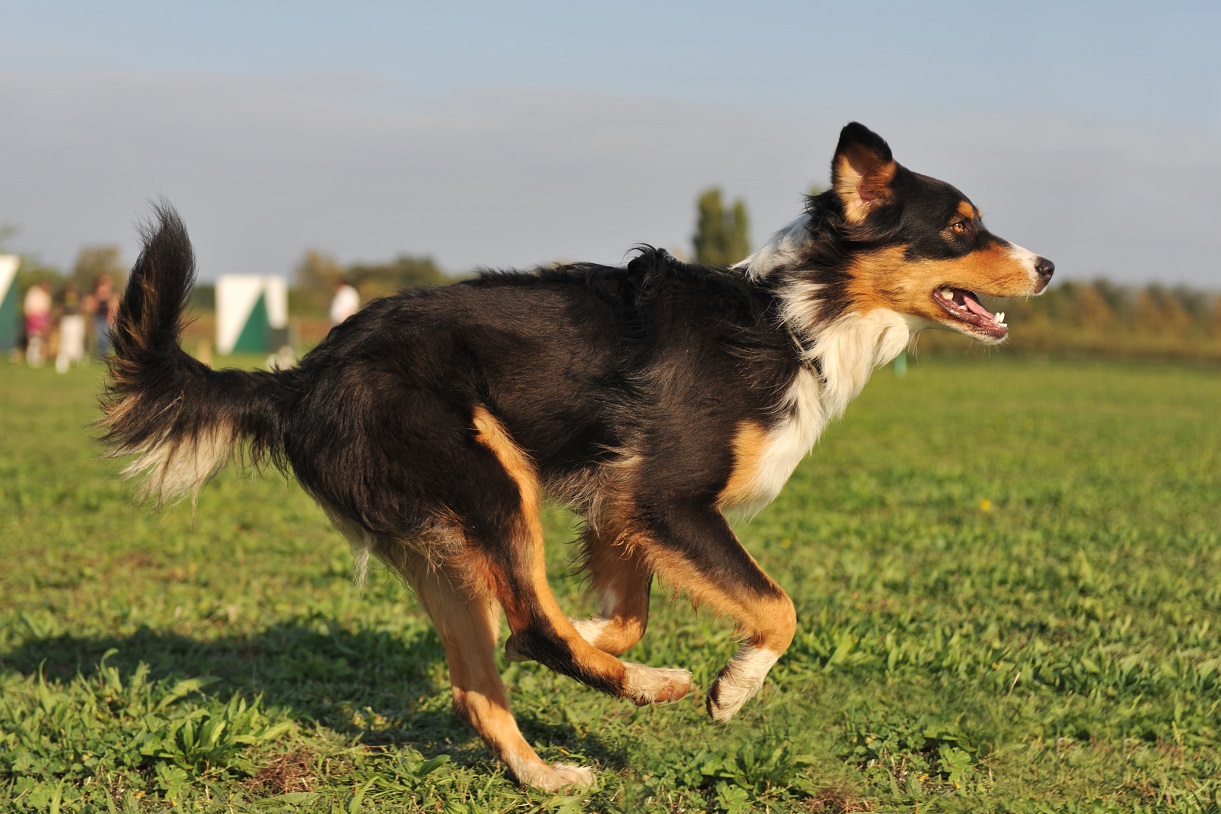If every dog trainer got a dollar each time they heard the phrase “My Australian Shepherd is out of control,” there’d be a lot of very wealthy dog trainers in the world.
Because let’s face facts. Australian Shepherds can be a handful. They’re bright (one of the brightest breeds around, in fact), they’re beautiful, and they’re blessed in a hundred and one other ways.
But for all their good looks and charm, they’re not always the easiest breed to deal with.
The high energy and intelligence that make Aussies such expert stock dogs can become a problem in the wrong circumstances. A bored, neglected, unexercised Aussie will invent its own fun and games.
Unfortunately, this can often result in a range of undesirable, anti-social behaviors, including barking, jumping, hyperactivity, and even aggression.
An out-of-control Aussie can be an embarrassment around strangers, a hazard to children, and a constant threat to your sanity.
But you know what? It doesn’t need to be this way.
Constantly worrying and stressing about your dog’s problematic behavior is natural. But it’s not achieving anything. If there’s a problem, it’s time for action.
It could simply be that you need to start exercising them more.
It could be that you need to dedicate more time to training.
But whatever the reason is and whatever the solution will be, the sooner you can identify the first and start implementing the second, the better.
Before you do anything else, I’ve got one word of advice for you. Check out The Dog Calming Code from the Online Dog Trainer, Dan Abdelnoor. (see video below)
While it’s not an overnight cure for your Aussies out of control behavior, I’m confident that if watch the video, implement the training Dan recommends, you’ll notice a dramatic improvement in their ability to focus and control their emotions.
Here’s the link to the video to take a look: Click Here To Discover How To Finally Solve Your Dogs Overexcited, Naughty Behavior… Even If You’ve Tried & Failed Before!
(video will open in a new window)
Why Is My Australian Shepherd Out Of Control?
No two dogs are the same. It’s part of their charm, but it’s also kind of annoying.
If every dog acted the same way for the same reason, we’d have a much easier time figuring out the motivation for their behavior.
But unfortunately, it’s not to be…
If you want to bring your Australian Shepherd’s behavior under control, you’re going to need to think carefully about what they’re doing, when they’re doing it, and what’s happening around them at the time.
Once you figure out what’s motivating the crazy behavior, you’re one step closer to bringing it under control.
Consider some of the following explanations for behavioral issues in dogs.
Do any strike a chord?
Encouraging Bad Habits
This isn’t a blame game. We all make mistakes with training from time to time. Often, we’re not even aware of what those mistakes are or when we’re making them.
But unfortunately, even innocent mistakes can have consequences.
If you’ve been rewarding bad habits like jumping, climbing over furniture, resource guarding, scavenging, and clinginess with too much attention and not enough boundaries. You might have inadvertently encouraged your dog’s bad behavior.
Health Issues
If your Australian Shepherd has suddenly changed from being a model of good behavior to an unpredictable, tantrum-throwing menace. They might be suffering from a health problem or injury.
As a medical complaint will need to be ruled out before anything else, be sure to take note of any other physical or behavioral changes you’ve noticed (a change in sleeping pattern or appetite, increased lethargy, exercise intolerance, etc.) to share with your vet.
Over-Exhaustion
Dogs, in many ways, are like kids. When a toddler gets over-tired, they get grumpy, testy, emotional, and way too hyper for their own good. A dog is much the same.
If your Aussie suddenly starts tearing around the house, jumping on the furniture, and generally acting like a massive pain in the proverbial, they might simply be overdue for a nap.

Lack of Exercise
The Australian Shepherd is one of the smartest, most energetic dog breeds you could meet. And while that’s great and lovely and all kinds of wonderful, it’s not without its problems.
When you welcome an Australian Shepherd into your home, you’re waving goodbye to your old, sedentary ways. Or you should be, in any case.
If you’re still living the couch potato’s dream, then there’s a problem… and the problem might be you.
If your idea of exercise involves going from the couch to the refrigerator and back again, it’s unlikely you’re meeting your dog’s prodigious activity needs.
Australian Shepherds need a minimum of 1 to 2 hours of high-intensity exercise a day. If they get more than the minimum, so much the better.
But without adequate activity, they’ll become bored, frustrated, and prone to finding less desirable outlets for their energy.
Boredom
When brains were being handed out, the Australian Shepherd was at the front of the queue. These are some of the smartest cookies in the dog world, and boy, do they like to show those smarts off.
Give them a trick to learn or a job to do, and they’ll jump at the chance to showcase their skills.
Give them nothing to occupy their days with, on the other hand, and you’ll be stuck with a bored, frustrated dog that’s forever up to no good.
Phobias and Fears
No dog is immune from developing fears or phobias in response to certain sounds, smells, or situations. Some of the most common forms of anxiety in Australian Shepherds include separation anxiety, social anxiety, and noise anxiety.
If a dog with anxiety is exposed to a triggering situation, they may display aggressive, fearful, and out-of-character behaviors.
Improper Socialization
Even though dogs are pack animals, they aren’t born with an innate understanding of how to interact with other animals and people. If you want your dog to grow up happy and well adjusted, early socialization is a must.
If this vital step is missed, a dog will find it difficult to know what is and what isn’t appropriate in social situations.
Related Post: How To Socialize An Aggressive Dog – A Step By Step Guide

Your Behavior
Again, this isn’t a blame game. We all have up days and down days. Life is tough. Venting is normal. But unfortunately, your emotions might be directly impacting your dogs.
Australian Shepherds are smart, sensitive creatures who easily and quickly pick up on their owner’s emotions. Like all pack animals, they’re also used to taking their cues from their leader (and yes, that means you).
If you’re stressed, or angry, or excited, there’s a very good chance your dog will start imitating your behavior and begin feeling the same way.
Conditioning
Sometimes, a dog will act the way they do simply because they don’t know any better.
When they’re young, dogs find it difficult to control their energy. If they’re awake, there’s a good chance they’ll be running around and causing mischief.
This kind of behavior is very natural and very normal. With time and training, most dogs will develop a calmer, more mature approach as they age.
On the other hand, if you constantly reward that behavior with attention (whether positive or negative). You’ll condition your dog into thinking they need to act a certain way to stay in the spotlight.
If your dog learns that being noisy and demanding makes them the focus of the room. They’ll be disinclined to put their childish behaviors aside as they mature into adults.
Changes in Routines or Environment
Dogs thrive on routine. They take comfort from knowing what to expect and when to expect it.
Although puppies and young dogs tend to adapt to change relatively easily, it’s a whole other story for older dogs who’ve become accustomed to a certain order.
Even minor changes to their routine or environment can throw a senior dog off balance.
If your Aussie feels overwhelmed by any recent changes, they may start acting out in new and unexpected ways.

How to Calm an Australian Shepherd
Once you’ve identified the reason for your Aussie’s behavior, you can start correcting it with the appropriate training and behavior modification techniques.
Before you get started on any new training regime, there’s one thing you need to remember. A tense, agitated dog isn’t going to learn a thing.
So before you do anything else, take a moment to check out The Dog Calming Code. Once you incorporate the Dan’s training into your routine, you’ll find your dog far calmer, far more focused, and far more inclined to sit up and pay attention.
Once you’ve watched the video and started introducing your dog to the exercises, you can get going with some of the following calming techniques.
Add Some Exercise
If your daily activity begins and ends with getting out of bed, it’s time for a change.
An under-exercised Australian Shepherd is a disaster waiting to happen. Remember, these are herding dogs who were bred to work from dawn to dusk.
Try to commit to at least 1 to 2 hours of regular, high-intensity exercise throughout the day.
Along with structured walks, introduce some fun into your Aussie’s day with a game of frisbee or tug-of-war.
If you’re away from home for long stretches, consider asking a friend or dog walker to break up your dog’s day with some high-energy interaction.
Invest in Some Toys
An Australian Shepherd isn’t a dog you can simply leave to snooze on the sofa all day long. They need to be kept active and mentally stimulated.
If you aren’t delivering the goods, you can bet they’ll find other ways to keep themselves amused… ways you’re not necessarily going to like.
If you want to harness all that energy for good, invest in some interactive toys and games that will keep your pooch happy and entertained for hours at an end.
Check Your Own Behaviors
Dogs can act like a mirror to our own emotions: if your behavior is erratic, there’s a good chance your dogs will be too. Hard though it is, try to stay controlled and calm around your pooch.
If you tend to get overexcited or over-emotional in certain situations, do what you can to keep it to yourself. It’s not going to be easy, and there’ll be days you can’t help but let your emotions run away with you.
But remember, you’re the leader, and where the leader goes, the rest of the pack follows. The calmer and more controlled you behave, the more inclined your dog will be to do the same.

Reward the Good and Ignore the Rest
Rewarding your dog with attention when they’re kicking up a fuss is a recipe for disaster.
Dogs want to be the focus of your attention at all times. Whether that attention is negative or positive really doesn’t matter.
The more you reward bad behavior with attention, the more you condition your dog to behave that way.
Take a step back. Next time your dog starts behaving badly, ignore them, turn your back, or leave the room. Wait until they’ve calmed down and are quiet before stepping in with some treats and praise.
The more consistent you are with rewarding the good and ignoring the bad, the better. The sooner your dog learns that acting out doesn’t get them anywhere, the sooner they’ll kick the habit.
Start Training
If you’ve never trained your Australian Shepherd, now’s the time to get down to some basic obedience training.
Australian Shepherds are superb students: teach them a command, and it won’t be long before they’ve got it down to a tee.
Not only will obedience training help you exert more control over your dog’s behavior, but it’ll also give them something to put their minds to.
And if there’s one thing all Australian Shepherds love, it’s working those big old brains of theirs.
Even if you’re not experienced in training, you should find it easy enough to master basic skills like sit, paw, down, and leave.
If you want to dial things up a notch, consider signing up for an obedience class – your dog will love the opportunity to show off their talents in front of an audience.
Focus Their Energy
Hyperactivity can get tiring fast. Fortunately, there are some easy ways you can help your dog regain their focus and calm down.
This is where watching and implementing the training from The Dog Calming Code comes in really handy if your dog struggles to keep their emotions in check and will quickly and easily put them on the path to success.
Use the training to focus your dog’s mind, and at any other time their emotions threaten to get the better of them.
Used with consistency, it’ll make a dramatic difference to your dog’s behavior… and your sanity!

Summing Up
Australian Shepherds make loyal, devoted companions. They’re smart, they’re loving, and they’ll stick to your side come rain or shine.
But don’t make the mistake of thinking that raising an Australian Shepherd is going to be sunshine and rainbows every day.
These are clever dogs that can easily become a challenge if their physical and mental needs aren’t met.
So make time for training, socialization, and plenty of exercise. The more time and energy you invest in your dog, the bigger the rewards.

